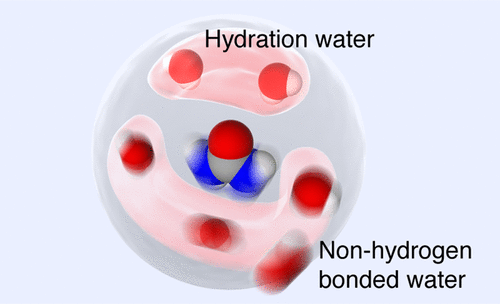当前位置:
X-MOL 学术
›
J. Phys. Chem. B
›
论文详情
Our official English website, www.x-mol.net, welcomes your
feedback! (Note: you will need to create a separate account there.)
Coexistence of Kosmotropic and Chaotropic Impacts of Urea on Water As Revealed by Terahertz Spectroscopy
The Journal of Physical Chemistry B ( IF 2.8 ) Pub Date : 2018-01-16 00:00:00 , DOI: 10.1021/acs.jpcb.7b11839 Keiichiro Shiraga 1 , Yuichi Ogawa , Koichiro Tanaka 2 , Takashi Arikawa , Naotaka Yoshikawa , Masahito Nakamura 3 , Katsuhiro Ajito 3 , Takuro Tajima 3
The Journal of Physical Chemistry B ( IF 2.8 ) Pub Date : 2018-01-16 00:00:00 , DOI: 10.1021/acs.jpcb.7b11839 Keiichiro Shiraga 1 , Yuichi Ogawa , Koichiro Tanaka 2 , Takashi Arikawa , Naotaka Yoshikawa , Masahito Nakamura 3 , Katsuhiro Ajito 3 , Takuro Tajima 3
Affiliation

|
Whether urea can serve as a kosmotrope or chaotrope has long been a topic of debate. In this study, broad-band THz spectroscopy (0.2–12 THz) of aqueous solutions of urea was used to characterize the hydration state and the hydrogen bond structure of water around urea. Three low-frequency vibration modes of urea were found around 2, 4, and above 12 THz. After eliminating the contribution of these modes, the “urea-vibration-free” complex dielectric constant was decomposed into the relaxation modes of bulk water and the oscillation modes of water. When hydration water is defined to be reorientationally retarded relative to bulk, our analysis revealed that the hydration number is 1.9 independent of urea concentrations up to 5 M, and this number is in close agreement with that of water constrained by strong acceptor hydrogen bonds of urea oxygen. Regarding the hydrogen bond structure, it was found that the tetrahedral-like water structure is mostly preserved (though the hydrogen bond lifetime is significantly shortened) but the population of non-hydrogen-bonded water molecules fragmented from the network is markedly increased, presumably due to urea’s NH2 inversion. These experimental results point to the coexistence of apparently two contradictory aspects of urea: dynamical retardation (the kosmotropic aspect) by the −CO group and slight structural disturbance (the chaotropic aspect) by the −NH2 group.
中文翻译:

太赫兹光谱显示尿素对水的同向性和离液性影响的共存
尿素是否可以用作共沸物或离液剂长期以来一直是争论的话题。在这项研究中,尿素水溶液的宽带太赫兹光谱(0.2–12 THz)用于表征尿素周围水的水合状态和氢键结构。在2 THz,4 THz和12 THz以上发现尿素的三种低频振动模式。在消除了这些模式的影响之后,“无脲振动”的复介电常数被分解为散装水的弛豫模式和水的振荡模式。当将水合水定义为相对于本体重新定向延迟时,我们的分析表明水合数为1.9,与尿素浓度最高5 M无关,并且该数字与受尿素强受体氢键约束的水的水合数紧密一致氧。2反演。这些实验结果表明,尿素显然存在两个相互矛盾的方面:-CO组的动态阻滞(同质性)和-NH 2组的轻微结构扰动(离液性)。
更新日期:2018-01-16
中文翻译:

太赫兹光谱显示尿素对水的同向性和离液性影响的共存
尿素是否可以用作共沸物或离液剂长期以来一直是争论的话题。在这项研究中,尿素水溶液的宽带太赫兹光谱(0.2–12 THz)用于表征尿素周围水的水合状态和氢键结构。在2 THz,4 THz和12 THz以上发现尿素的三种低频振动模式。在消除了这些模式的影响之后,“无脲振动”的复介电常数被分解为散装水的弛豫模式和水的振荡模式。当将水合水定义为相对于本体重新定向延迟时,我们的分析表明水合数为1.9,与尿素浓度最高5 M无关,并且该数字与受尿素强受体氢键约束的水的水合数紧密一致氧。2反演。这些实验结果表明,尿素显然存在两个相互矛盾的方面:-CO组的动态阻滞(同质性)和-NH 2组的轻微结构扰动(离液性)。











































 京公网安备 11010802027423号
京公网安备 11010802027423号